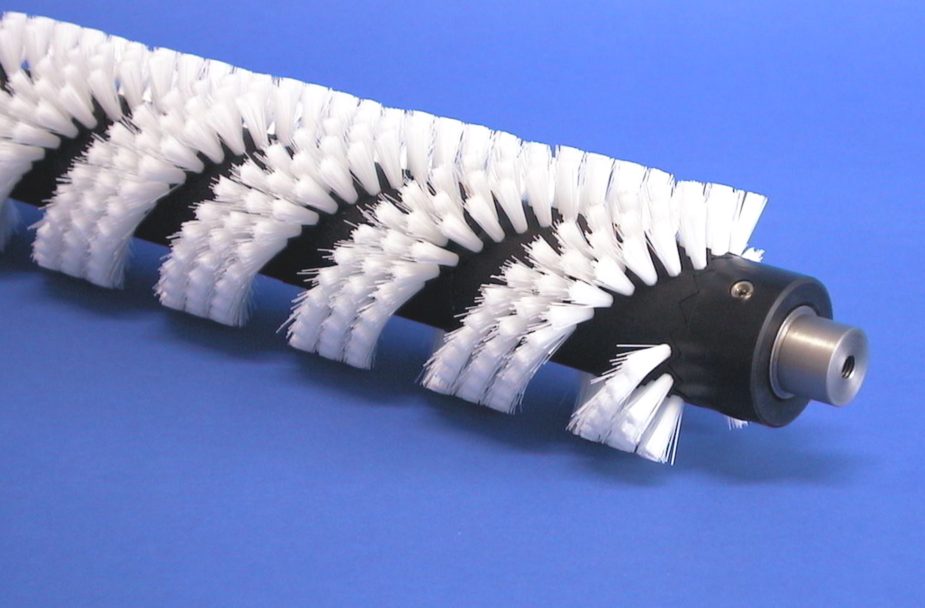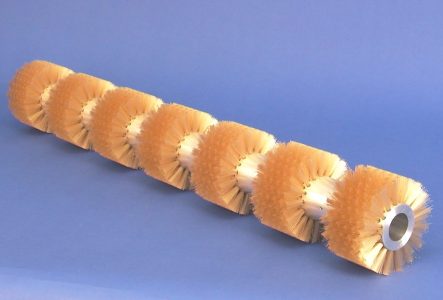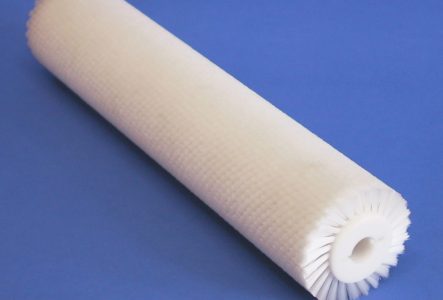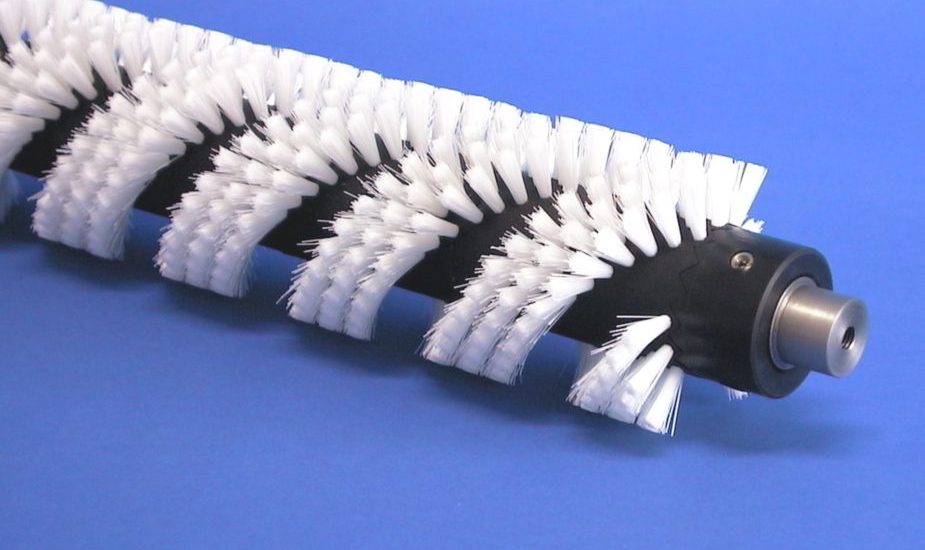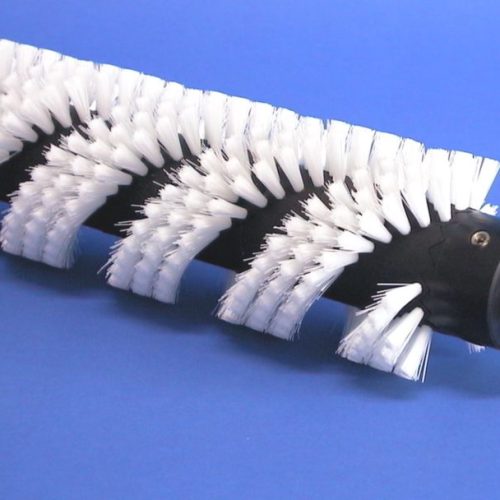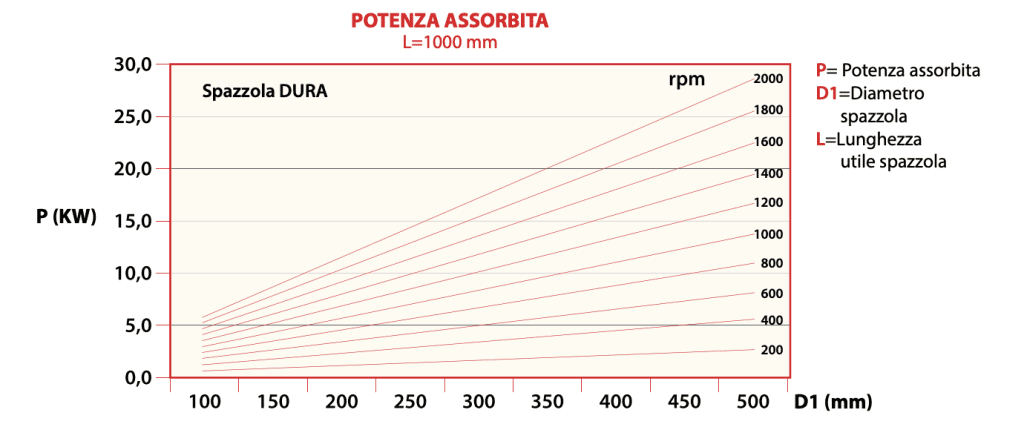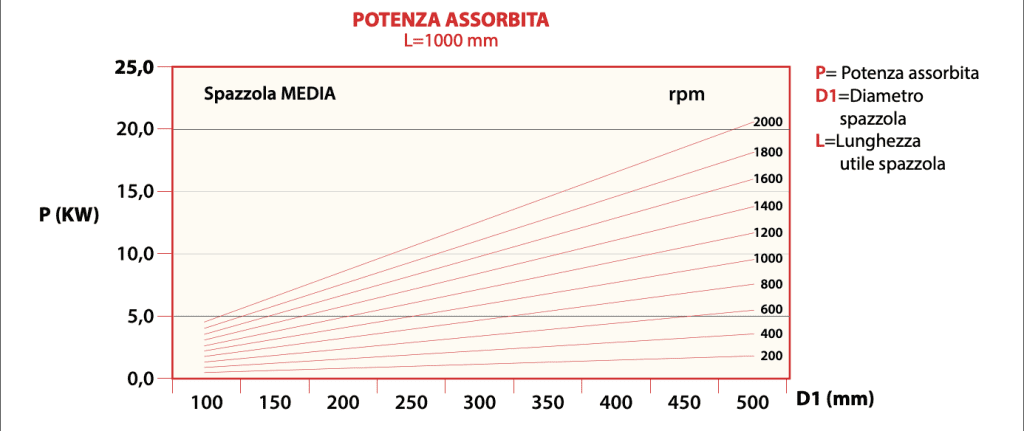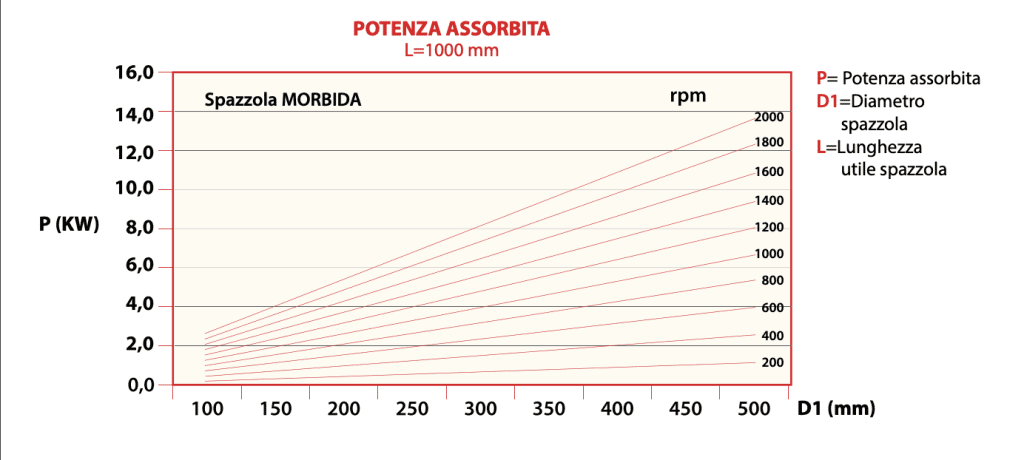Punched roller brushes
Punched roller brushes
Generalities
They are the most common type in industry, as they are used in many production processes. They are generally motorised brushes, i.e. equipped with a metal core capable of withstanding considerable torque. However, they can also be supplied without a metal core. The working surface can be continuous, sectoral, helical, conical, shaped according to drawing. For large rollers or rollers rotating at high speed, a dynamic balancing operation is important, which we perform in-house and can provide the customer with a detailed balancing certificate.
The rollers are used for:
- Precision brushes
- Brushes with complex geometric shapes
- Brushes with mixed filaments or alternating sectors of different filaments
- Modular brushes
- Soft and gentle brushes
The bundles are generally radial, but it is possible to give them a transverse tilt, so as to make the brush rotationally asymmetrical.
This can be useful to soften the action of the roller or to prevent the material from moving in the opposite direction to the motion. The angle α cannot generally exceed 30°.
The rollers are almost always motorised. For this, steel brush bodies with hubs, flanges, tongue housings, etc. are provided.
Sometimes, for technical reasons, rollers are made on a composite body with different materials. Dynamic balancing can only be performed on rollers with a metal body, as they are ‘non-deformable’.
Roller brushes with D1>L are called round brushes.
They can work in small spaces and can be placed side by side on the same shaft until a roll is obtained, but it will not have the same continuity as a single piece.
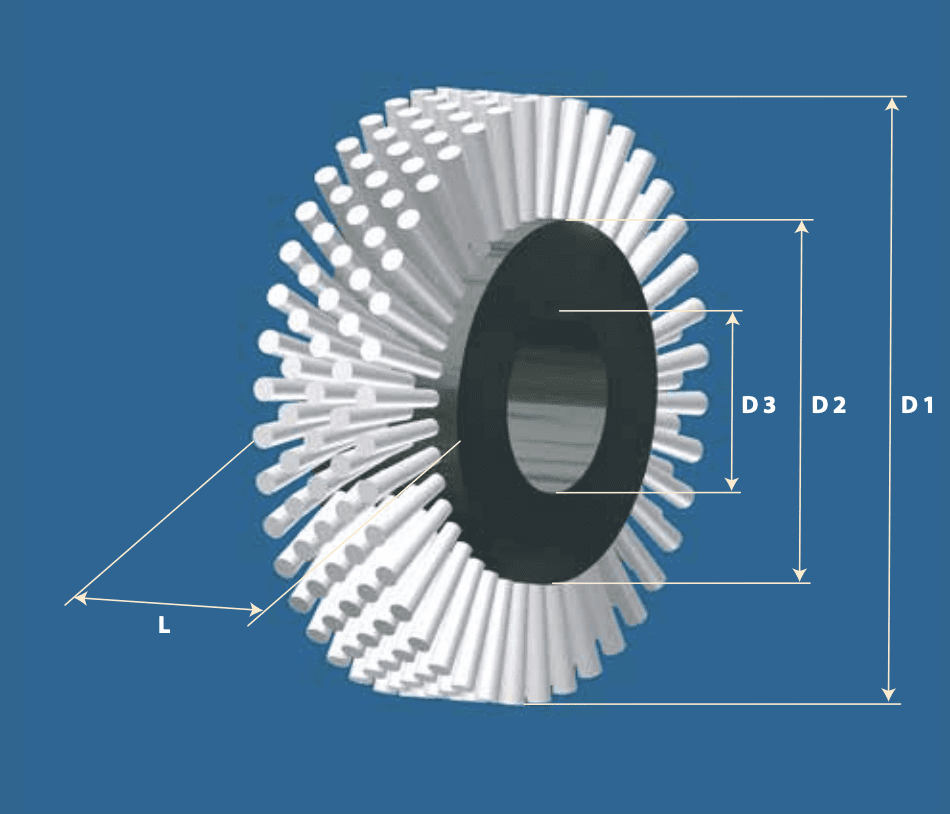
An important fact to know at the design stage is the rotational speed at which a roller can be driven. This depends not only on the materials, but also on the load on the brush and the filament-surface friction coefficient. We can calculate the acceptable number of revolutions n of the brush with a function ‘f’ of the static and dynamic parameters and check that it is:
n < f (s, Ft, Pm, D1, D2, P) where s = safety coefficient, which must take into account the type of load appliedFt = resistance of the bundle to tearing [Kg] Pm = weight of the bundle [gr] P = depth of the bundle hole [mm]
We are available to provide you with the necessary project data. At high speeds, a sample must in any case be made and tested under safe conditions.
It is important to provide a suitable motor to drive the roller brush. Power consumption varies depending on brush diameter, speed, working length and filament hardness. It is also greatly affected by the pressure exerted on the brush.
It is therefore only possible to establish the power as an average value and as a first approximation. The diagrams shown give the motor power for a brush length of 1000 mm.
For different lengths, the arithmetic proportion is followed.
Rollers of the desired length can be assembled using modules of standard length 100 mm.
The modules are cylinders of various diameters and holes, which have a toothing at both ends that has two functions:
- transmitting motion between two modules
- realise the continuity of the brushing surface even in the seam lines. At the ends of the roller thus composed are two toothed collars with threaded grub screws that lock the brush.
The brush body is made of PP, and a white version for food use is also available. The brushing surface can be continuous, sectoral or spiral. The number of bundles depends directly on the number of Z teeth, so brushes with different densities are possible, according to the table. Modular rollers have the advantage that they can form brushes of different lengths and are easy to replace and transport. On the other hand, they have a certain limitation in diameters and bundle arrangement. In fact, these parameters are constrained by the characteristics of the brush body, which being obtained by moulding does not allow for all possibilities. In other words, the modular method can replace the traditional one-piece brush only for the standard dimensions shown in the table.
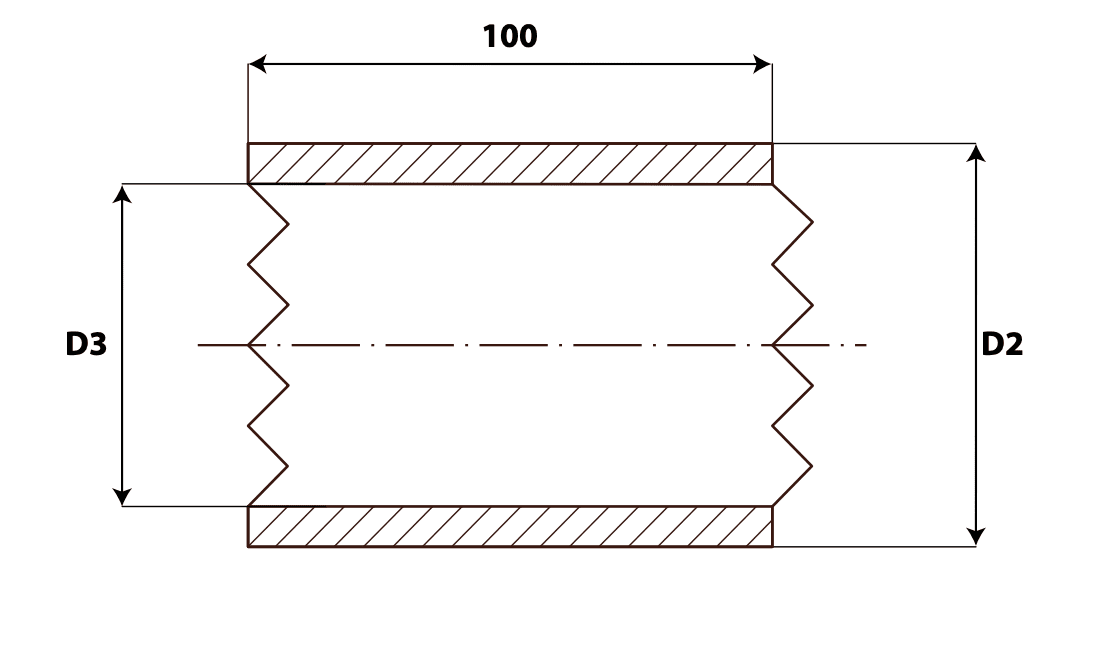
Modular brush bodies L = 100 mm
| D2 (mm) | D3 (mm) | Z | R |
|---|---|---|---|
| 31 | 20 | 6 | B |
| 31 | 20 | 8 | M |
| 31 | 20 | 10 | A |
| 45 | 25 | 8 | B |
| 45 | 25 | 12 | M |
| 45 | 25 | 16 | A |
| 50 | 30 | 10 | B |
| 50 | 30 | 12 | M |
| 50 | 30 | 16 | A |
| 57 | 35 | 10 | B |
| 57 | 35 | 15 | M |
| 57 | 35 | 18 | A |
| 65 | 40 | 12 | B |
| 65 | 40 | 17 | M |
| 65 | 40 | 20 | A |
| 75 | 50 | 12 | B |
| 75 | 50 | 18 | M |
| 75 | 50 | 30 | A |
| 86 | 60 | 12 | B |
| 86 | 60 | 20 | M |
| 86 | 60 | 30 | A |
| 100 | 75 | 14 | B |
| 100 | 75 | 18 | M |
| 100 | 75 | 22 | A |
| 125 | 100 | 18 | B |
| 125 | 100 | 24 | M |
| 125 | 100 | 28 | A |
Z = Number of teeth; R = Reticle; B = Low intensity; M = Medium intensity; A = High intensity
is a brush specially designed for cleaning photovoltaic and solar panels. In fact, it is well known that panels require periodic cleaning to prevent them from reducing their efficiency due to dust of various kinds. Sunny Brush is modular, so that it can be adapted to the various types of panels on the market.
The constituent elements are:
- aluminium core in 1,000 mm modules
- D=200 mm nylon brush in 100 mm modules
- POM-C joint bushings with threaded inserts
- locking collars and end finishing The modularity allows the user to order a brush of the desired length (even several metres) and to easily assemble it on the roof using simple screws. Other advantages of modularity (both core and brushes) are cost-effectiveness and ease of transport.
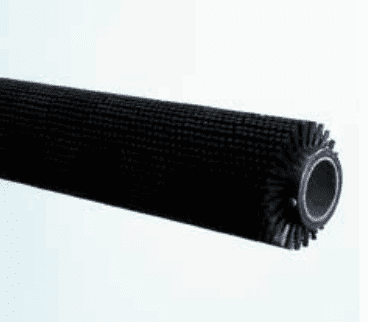
Videos and images
GALLERY
Do you want to request an offer?
Are you interested in receiving more information and being contacted by one of our specialized operators?
Request your offer now

Do you want to request an offer?
Are you interested in receiving more information and being contacted by one of our specialized operators?
Request your offer now
Frequently asked questions
What is the advantage of using a brush instead of another deformable object?
The special feature of the brush is that the working surface consists of millions of individual elements, which are the ends of individual filaments.
This gives the brush an adaptability that no other element, however deformable, can have.
How much must the brush interfere with the workpiece?
It depends on various factors. In a nutshell, it can be said that 2 mm is a good compromise. The important thing is that the brush filaments work ‘on the tip’ and not on the side.
Can a bundle of filament be detached from the brush body?
Depending on the materials used and the dimensions, there is a limiting tensile load that an individual bundle can withstand.
Beyond this limit, the bundle comes off, so the brush must be calculated according to use. This limit can be greatly increased by constructing ‘sewn’ or ‘tied’ brushes by hand, where instead of a single anchoring element, a continuous steel wire is placed.
Is a punched brush or a strip cheaper?
There is no single answer. Speaking of e.g. cylindrical brushes, the strip brush is generally cheaper when the dimensions are large (e.g. over one metre in length). For small dimensions, punched brushes are certainly more suitable and convenient.
Is it possible for a single filament to slip out of the bundle and contaminate the product?
This can only happen if the brush has a manufacturing defect, like any other type of object (e.g. a roller made of silicone flakes, one of which is defective and breaks).
When it is important that no contamination occurs, synthetic (not natural) fibres with a diameter greater than or equal to 0.15 mm should be used.
What softness or hardness of brush can I achieve?
Practically all degrees of hardness are possible, from very soft to very hard. In fact, hardness is a combination of the filament diameter, its free length and the density of the bundles.
Is it possible to have a certified 'food grade' brush?
Of course, we can provide FDA or FOOD GRADE certification and filament traceability.
Is it possible to have an ATEX-certified brush?
Unfortunately not, as it is the machine + brush assembly that needs to be ATEX certified, not the brush alone.
However, it is possible to supply the materials that the certifier requires, e.g. conductive bases, conductive filaments, etc.
Is it possible to 'regenerate' a worn-out brush?
Generally speaking, it is possible, but one has to assess whether it is cost-effective, which is not always the case. In addition, in the case of a punched brush, it is inadvisable to regenerate the brush more than twice, so as not to reduce the tightness of the bundles.

